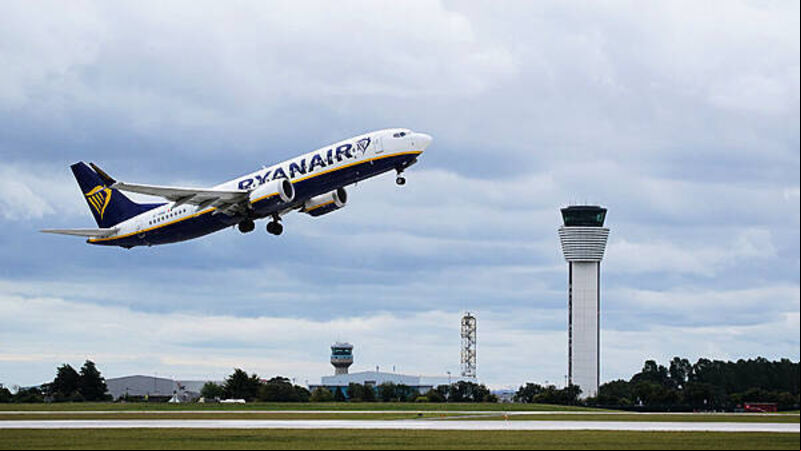One person submitted over 7,000 Dublin Airport noise complaints in one month

Seán McCárthaigh
The annual number of complaints about aircraft noise at Dublin Airport more than doubled last year to almost 71,000, with one individual submitting a record 7,535 complaints in a single month.
Figures published by the airport’s operator, DAA, show a total of 70,939 complaints about noise from aircraft landing and taking off in Dublin were recorded last year – an increase of over 37,000 on 2023 levels.
They include large numbers of complaints from a handful of individuals with DAA claiming that “serial complainants” for nine out of every 10 cases.
The figures show one individual living close to a main flight path in St Margaret’s, Co Dublin submitted 7,535 complaints in August 2024 – a daily average of 243 complaints – as part of over 18,000 complaints filed between July and September last year.
While a few individuals who file large volumes of complaints can skew overall numbers, the latest figures show that more complaints are still being received even when the impact of “serial complainants” is excluded.
DAA’s figures show the top five individual complainants each month ed for 46,197 complaints last year – representing 65 per cent of the total number of complaints – and up from just over 19,700 in 2023.
However, complaints from others rose by 81 per cent to 24,742 last year – an annual increase of over 11,000.
The figures also show that the average number of individuals who filed complaints each month in 2024 was 152 – down from 290 the previous year.
The trend would indicate that while fewer individuals are now submitting complaints to DAA about noise from aircraft using Dublin Airport, they are doing so on a more frequent basis.
According to DAA figures, approximately five per cent of aircraft do not adhere to designated flight paths and are considered “off track.”
DAA did not comment on what sanctions, if any, were applied for such deviations but said it worked closely with airlines “to improve adherence to flight paths.”
DAA media relations manager, Graeme McQueen, said some flux in complaint levels in recent years was “not surprising given that North Runway is still a relatively new piece of infrastructure which is bringing new noise to some people for the first time.”
DAA did not provide a breakdown of complaints relating to the €330 million North Runway which became fully operational in late 2023, although its use is generally limited to 7am-11pm.
However, DAA figures show that 65 per cent of all departures last year used the North Runway, while 81% of arrivals land on the South Runway.
Mr McQueen claimed significantly fewer people were now impacted by aircraft noise than previously as a result of the opening of North Runway.
He added: “That's due to the significantly reduced usage of our Crosswind Runway, which resulted in planes flying over heavily populated areas of Dublin City, the use of more modern and quieter aircraft and the adoption of DAA's extensive noise mitigation measures.”
The figures show that during the winter season, the largest volume of complaints relates to flights between 7am and 9am with a smaller peak in the evening.
However, complaints are spread more evenly across the day during the peak season in the summer.
Approximately 37 per cent of complaints relate to flights operated by Ryanair, while 28% are linked to Aer Lingus aircraft with the remainder ed for by other airlines.
Data published by DAA indicates that the main locations where complainants reside include St Margaret’s, Ratoath, The Ward, Ashbourne, Swords, Kilsallaghan, Malahide and Portmarnock.
Airlines using Dublin Airport are required to adhere to a “noise preferential route” as their flight path until departing aircraft reach 3,000 feet altitude or 4,000 feet for flights using the North Runway.
Arriving aircraft must fly in a straight line for at least the final 11km of their approach when they are at a height of 1,800 feet.
A recent study commissioned by St Margaret’s/The Ward Residents’ Group, who are fighting a campaign to keep the controversial cap of 32 million engers using Dublin Airport annually, estimated that noise from aircraft is seriously affecting the health of 17,000 living in the area at a cost of almost €800 million.
The research carried out by PMCA Economic Consulting used figures from the latest annual survey by the Aircraft Noise Competent Authority which showed 71,388 local residents were “highly annoyed” by aircraft noise with 32,562 classified as “highly sleep disturbed.”
The research said the ANCA statistics indicated 16,746 people living around the airport have been impacted by heart issues with a total of 120,696 affected with general health problems.
The group’s spokesperson, Niamh Maher, said aircraft noise was causing real harm to local residents with the research now showing the cost in economic .
“The health impact on people’s lives by the relentless pursuit of driving up enger numbers at Dublin Airport surely demands a rethink,” said Dr Maher.
The residents have called for more balanced airport development in the Republic with greater use of airports at Shannon, Cork and Knock.
Earlier this month, DAA launched a new noise information portal on its website to provide interactive information about flights to and from Dublin Airport.
Mr McQueen said the initiative was introduced after an extensive community survey had shown people wanted more transparency, openness and access to information on airport operations and noise management.
The portal allows individuals to analyse the noise situation from aircraft at their location as well as to check their eligibility for insulation and home buy-out schemes.
DAA said it had spent over €20 million to date on insulation schemes and purchasing homes in the vicinity of the airport.
It claimed almost 230 homeowners most affected by aircraft noise were eligible for insulation schemes with 186 homes already completed.
A further 400 homes are to benefit from a grant scheme for insulation worth €30,000 per property.
In addition, a voluntary buy-out option has been made available to 41 families living near the airport with offers about 30% over market values plus “generous” allowances for stamp duty, conveyancing and moving costs.
DAA said six purchases have been completed so far with a further 14 in process.
“We have to strike a balance between operating a major international airport and ensuring Ireland has the connectivity it needs, with the needs of those living close to the airport,” said Mr McQueen.
“That’s always going to be difficult, but we are constantly working to minimise the impact and listening to community ,” he added.









